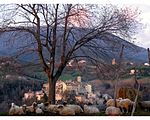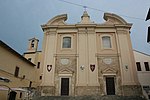Selci, Italy
Cities and towns in LazioLazio geography stubsMunicipalities of the Province of RietiPages with Italian IPA
Selci (Italian: [ˈseltʃi]) is a comune (municipality) in the Province of Rieti in the Italian region of Latium, located about 45 kilometres (28 mi) north of Rome and about 25 kilometres (16 mi) southwest of Rieti. As of 31 December 2004, it had a population of 1,038 and an area of 7.8 square kilometres (3.0 sq mi).Selci borders the following municipalities: Cantalupo in Sabina, Forano, Tarano, Torri in Sabina.
Excerpt from the Wikipedia article Selci, Italy (License: CC BY-SA 3.0, Authors).Selci, Italy
Via Aurano,
Geographical coordinates (GPS) Address Nearby Places Show on map
Geographical coordinates (GPS)
| Latitude | Longitude |
|---|---|
| N 42.316666666667 ° | E 12.616666666667 ° |
Address
Via Aurano
Via Aurano
Lazio, Italy
Open on Google Maps







